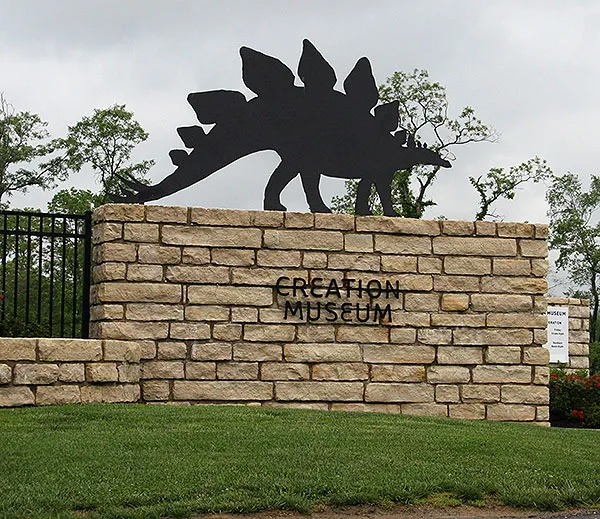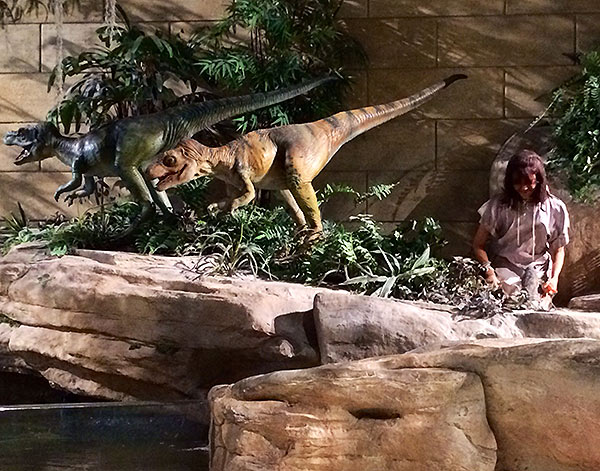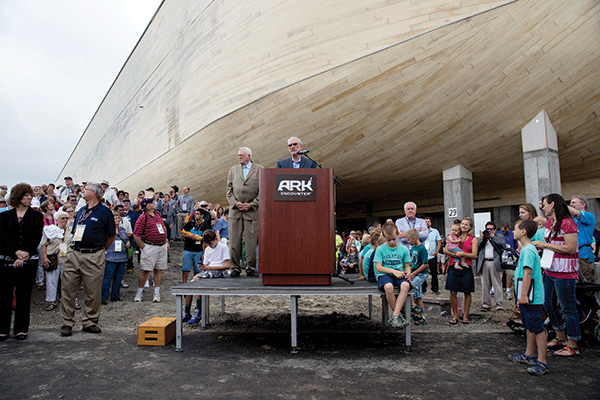The moment its doors officially open, the new Museum of the Bible, with its prime real estate in the capital, will be the nation’s most prominent institution dedicated to educating the general public about Judeo-Christian ideas and history. But it is far from the first attraction built by evangelical Christians to celebrate and explain their beliefs; the precedents range from the relatively highbrow, like museums that collect and display art with biblical themes, to the hands-on and in-your-face, like the Holy Land Experience, an Orlando theme park that re-creates the ancient world of the Bible. Some of these institutions have been associated with famous evangelical figures, like the Billy Graham Library in Charlotte, N.C., which honors that preacher’s ministry, and the now-closed Heritage USA theme park in Fort Mill, South Carolina, started by the notorious televangelists Jim and Tammy Faye Bakker.
The American landscape is dotted with similar attractions—pilgrimage sites, you might say. Among the longest-lived and most financially successful are the Sight & Sound Theatres, the original in Lancaster County, Penn., and a younger sibling in Branson, Mo. Both facilities, nearly identical, are professional theaters that stage biblically based musicals on a vast scale. The building housing the Lancaster theater is beautiful, warmly lit, and when I toured it in October was already decorated for Christmas. At the outside entrance, visitors are greeted by a statue of a lion lying down with a lamb. Sight & Sound is famous for its candied almonds, the scent of which lends the air a delicious holiday perfume even before you reach the front doors. The lobby is biblically themed, replete with palm trees and statues of heralding angels.
Sight & Sound was founded by Glenn Eshelman, who in the 1970s discovered his knack for showmanship when presenting his landscape photography at Lancaster-area churches. Working with his wife, Eshelman spiffed up his slideshows with a microphone for narration and a turntable for background music; they soon added more projectors and started touring their multimedia productions at churches around the country. By the mid-’70s, the Eshelmans moved into their first permanent location. They began to add live music, dancers, and costumed performers to their shows. Soon they outgrew their original theater, and in 1991 built a new one in the neighboring cornfield, and then, after a fire, built the current 2,000-seat theater in 1998. The Branson location opened in 2008.

A scene from the Sight & Sound Theatres production ‘Samson.’ (Credit: Sight & Sound Theatres)
The Bible, taken literally, serves as the basis for all of Sight & Sound’s shows, but it’s a relatively generous orthodoxy. The Eshelmans’ first full-scale musical, Behold the Lamb, debuted in 1987. In later years, they began to specialize in epic productions, mostly drawn from the Old Testament—In the Beginning, a dramatization of the Genesis creation story; Noah, the story of the flood; and Samson, which featured crumbling pillars bigger than any Sunday-school student could imagine.
The Sight & Sound team is highly professional, capable of staging productions beyond the capacity of most theaters. The stunts and effects are worthy of Broadway. The main stage is 300 feet long and panoramically wraps around the audience on three sides. Live animals feature in many scenes, including camels, horses, goats, donkeys, sheep, chickens, and doves. (The Sight & Sound production of Jonah did not, alas, feature a live whale.) In the theater’s control room, which resembles the operations center of a nuclear power plant, buttons labeled “Heaven out” and “Heaven in” control the invisible wires that make the angels fly.
Sight & Sound does all its own set work in a shop in the rear of the theater complex; it resembles a massive airplane hangar. There props up to 40 feet tall are fabricated in incredible detail, sometimes with 3D-printing technology.
Not all Sight & Sound shows are based on the Old Testament. During my visit I saw this year’s run of The Miracle of Christmas; Joseph and Mary were played by professional actors with professional costumes—forget the oversized bathrobes from your church’s Christmas pageant. And the show Jesus is set to open in March 2018 after three-and-a-half years in development. It will make use of an enormous new LED screen—more than 100 feet long and over three stories tall—purchased for $1.3 million.
Unlike the new Museum of the Bible in Washington, Sight & Sound is ready to evangelize. There’s an altar call at the end of every performance, and theater staff stand ready to pray with believers and nonbelievers alike. And unlike the new museum, Sight & Sound is a for-profit enterprise. Still, there is an important lesson the Green family that founded the new museum can learn from Sight & Sound: Quality speaks for itself. Some 1.4 million people attended shows at the two Sight & Sound theaters in 2016, nearly triple the number who saw Hamilton last year, and the company has been profitable for decades. All this success has been possible without some of the advantages the new museum enjoys, like deep-pocketed funders and attention from national media.
One other lesson the Green family might learn from Sight & Sound: Don’t underestimate the power of a catchy showtune. A little razzle-dazzle can go a long way.
* *
As the plans for the Museum of the Bible emerged in recent years, some critics worried that it would turn out to be a site for indoctrination. “I don’t expect the Bible Museum to be anything other than a tax-deductible kitsch attempt at spreading Christian fundamentalist propaganda,” archaeologist Dorothy King complained to the Washington Post in 2015. The fear, for some of these critics, was that the new institution would turn out something like the Creation Museum.

(Credit: Flickr user joevare [CC BY-ND 2.0])
Ken Ham, the Creation Museum’s founder, was an Australian schoolteacher before he moved to the United States in the 1980s and founded what would eventually become Answers in Genesis—a fundamentalist Christian organization that advocates Young Earth creationism, the belief that God made the universe in six literal days, the whole thing has been ticking for just 6,000 years (give or take a few), and evolution is bogus. The group is very productive, maintaining a well-trafficked website, a print magazine with 65,000 subscribers, and, most importantly, the Creation Museum in Petersburg, Ky. The museum’s stated mission is to “point today’s culture back to the authority of Scripture and proclaim the gospel message.” Answers in Genesis selected Petersburg as the site for the museum because two-thirds of the country’s population lives within a day’s drive.

So happy together: Dinosaurs and human beings living in harmony at the Creation Museum. (Credit: Flickr user amerune [CC BY 2.0])
Stepping through the Creation Museum’s front doors, the visitor is immediately greeted by a life-size diorama now infamous because it’s an easy target for journalists: It shows an idealized jungle scene with human children and dinosaurs coexisting happily. Mountains of scientific evidence show that such a thing never happened—human beings and dinosaurs are separated by tens of millions of years—but the Creation Museum presses on.
The museum is big enough to fill a full day of meandering. The main exhibit is called the Bible Walkthrough Experience, with each room given an allegorical name so that the whole has a Pilgrim’s Progress feel: The “Time Tunnel” is followed by the “Cave of Sorrow,” which leads to “Legacy Hall.” Ken Ham once told NPR that at the museum, “we actually do give both sides,” and that’s the honest-to-God truth—the visitor is offered a choice between creationism and the conclusions of (if not the reasoning for) evolution, but it’s a choice with ultimate consequences: Pick evolution and you’re slipping toward atheism, sin, and damnation.
In addition to the exhibits, there are theaters and even a planetarium. What, you may wonder, could possibly be said in a planetarium at a museum dedicated to the proposition that the universe is just a few thousand years old? For the most part, the planetarium program marvels at the beauty of the natural world, taking colorful nebulae and huge stars as evidence for the greatness of God. But on matters where astronomical evidence clashes with Young Earth dogma, the planetarium program dismisses or distorts the science.
Beautiful gardens surround the museum, as well as a zip-line course and a petting zoo that offers camel rides. Themed restaurants such as “Noah’s Café” and “Palm Pizza” serve hearty Americana; gluten-free and vegetarian options include the “Eden Wrap.”
The whole museum is organized, as Susan and William Trollinger point out in Righting America at the Creation Museum, according to dispensational premillennial theology, which explains all of world history in seven phases and warns that a society that rejects God will suffer his wrath. This narrative plays itself out on scales both small (in the lives of every individual) and large (all of human history). The end times are coming, and Christians are called to save as many souls as possible.

Ark Encounter (Credit: Flickr user scott1346 [CC BY 2.0])
A 45-minute drive south from the Creation Museum brings visitors to Ark Encounter, a model of Noah’s life-saving ship, built to the specifications laid out in the Bible and aided by a great deal of speculation about how Noah and his seven family members crammed 7,000 animals aboard plus the necessary provisions. Before my recent visit, I had seen plenty of photographs, but they couldn’t have prepared me for the awe-inspiring reality as the ark came rising up over a hillside. At 50 feet tall and 510 feet long, the ark is the largest timber-framed structure in the world—longer than three NASA space shuttles parked end-to-end. Answers in Genesis hopes that Ark Encounter, which opened to the public in July 2016, will ultimately be just the centerpiece of a theme park re-creating other stories from Genesis as well.

Ken Ham addresses a crowd at the ribbon-cutting ceremony for Ark Encounter on July 5, 2016. (Credit: Aaron P. Bernstein, Getty)
Some 2,600 people were at Ark Encounter the day I visited, milling around exhibits discussing ancient, cross-cultural flood stories and the meaning of climate change. As one guest who boarded the ark with me said in awe, “it’s so . . . slick.” Polished wood ramps angle you through four long decks. And what would the ark be without animals—both real ones, on the second floor, and animatronic creatures in cages, bristling with scales or fur, most growling and whooping exotically. Dioramas show Noah’s family—sometimes mannequins, sometimes animatronic—lounging around or praying to God (instead of, say, scooping the 12 tons of manure Answers in Genesis estimates were produced on the ark every day).
* *
Take a walk through the bookstore back at the main Creation Museum and you’ll find a wide selection of what Answers in Genesis calls “advanced ‘weaponry’ ” for the fight against secularism—DVDs, devotionals, and homeschooling resources. No doubt you’ve wondered, “Where did Cain get his wife?” There’s a tract for that in five languages. You can find a booklet answering the question “Where Did the ‘Races’ Come From?” and publications explaining such complex topics as the cardiovascular system (“the world insists that our bodies are merely the result of time and chance . . . [but they] can only be the product of a Master Designer”).
Yet there are also hints that Answers in Genesis is battling not just “secularists” but also many fellow Christians. The bookstore includes a guide for identifying which Christian colleges are counterfeit. Elsewhere, a plaque cautions that “many church leaders compromise on the truth of Genesis.” Ken Ham has lamented “that we (sadly) have now come to expect a steady stream of negative comments” from co-religionists.
This is the key to understanding the Creation Museum: With only enemies in the secular world and few allies in the church, the museum aims to be entirely self-sufficient, a one-stop shop for a certain strain of theology. As the Trollingers put it, the museum attempts to instruct visitors in “a totalizing history . . . that reveals the hidden truth for all time.” Spend long enough in the bookstore and you’ll eventually notice the same authors keep popping up again and again—Ham himself has written some 30 books and participates in hundreds of seminars every year.
For all its insularity, though, the Creation Museum is, on its own terms, hugely successful. And it’s way more fun than anything you’ll find in the Smithsonian.
Perhaps it’s understandable that some observers put off by the intellectual dishonesty of the Creation Museum might be wary of the Museum of the Bible—after all, it isn’t hard to find parallels between Ken Ham and Steve Green, the chairman of the new museum’s board of directors. Ham refers to the Bible as “a history book that reveals the major events of history”; Green refers to it as “a reliable historical document.” Ham’s organization sells extensive curriculum materials; the Museum of the Bible has experimented with an “elective Bible curriculum for high school students.” Ham has said that our culture is “becoming more like the days of Noah in that we see increasing secularization”; Green has warned that “this nation is in danger because of its ignorance of what God has taught. . . . We need to know [the Bible]. And if we don’t know it our future is going to be very scary.” And there is an institutional link between the two organizations: The Museum of the Bible has permanent exhibits at the Creation Museum and Ark Encounter.
Steve Green and his family had every resource at their disposal to build a bigger, better Creation Museum had they wished to do so—but they chose a different path. The Museum of the Bible “has fenceposts—limits,” Green told the Chicago Tribune. “It doesn’t overtly say the Bible is good—that the Bible is true.” A visitor to the Museum of the Bible won’t likely come away converted or even feeling like he had been preached to; in fact, if he came to the museum looking for spiritual reinforcement he may even leave feeling somewhat unfulfilled. In the place of stridency and elaborate dogma, the new institution offers the artifacts and texts themselves. Its creators can only hope that museumgoers will have the ears to hear and eyes to read the Word.
Grant Wishard is an editorial assistant at THE WEEKLY STANDARD.

